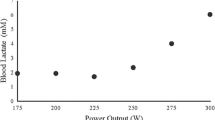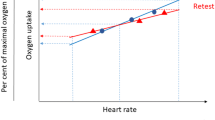Abstract
From a population of 20 healthy male volunteers, half performed constant speed, incremental load maximal aerobic capacity (\(\dot V_{O_2 \max } \)) tests on a motor-driven treadmill, while the other half performed similar\(\dot V_{O_2 \max } \) tests on a bicycle ergometer. The two groups, matched for size and age, showed no significant differences in\(\dot V_{O_2 \max } \), maximum heart rate, or in post-exercise (4 min) peripheral venous blood concentrations of lactate or pyruvate. However, post-exercise peripheral venous blood ammonia levels were significantly higher in the group tested on the bicycle ergometer than in the treadmill group.
Similar content being viewed by others
References
Allen, S. I., Conn, H. O.: Observations on the effect of exercise on blood ammonia concentration in man. Yale J. Biol. Med.33, 133–144 (1960)
Altman, P. L., Dittmer, D. S. (Eds): Blood and other body fluids. Bethesda, Md.: Fed. Amer. Soc. Exp. Biol. 1971
Drinkwater, B. L., Horvath, S. M.: Responses of young female track athletes to exercise. Med. Sci. Sports3, 56–62 (1971)
Embden, G., Wassermeyer, H.: Über die Bedeutung der Adenylsäure für die Muskelfunktion. 3. Das Verhalten der Ammoniakbildung bei der Muskelarbeit unter verschiedenen biologischen Bedingungen. Z. physiol. Chem.179, 161–185 (1928)
Lowenstein, J. M.: Ammonia production in muscle and other tissues: the purine nucleotide cycle. Physiol. Rev.52, 382–413 (1972)
Luck, J. M., Thacker, G., Marrack, J.: Ammonia in the blood of epileptics. Brit. J. exp. Path.6, 276–279 (1925)
Michael, E. D., Jr., Horvath, S. M.: Physical work capacity of college women. J. appl. Physiol.20, 263–266 (1965)
Parnas, J. K.: Ammonia formation in muscle and its source. Amer. J. Physiol.90, 467 (1929)
Parnas, J. K., Mozalowski, W., Lewinski, W.: Über den Ammoniakgehalt und die Ammoniakbildung im Blut. IX. Der Zusammenhang des Blutammoniaks mit der Muskelarbeit. Biochem. Z.188, 15–23 (1927)
Winer, B. J.: Statistical principles in experimental design, 2nd ed. New York: McGraw-Hill 1971
Author information
Authors and Affiliations
Additional information
This work was supported in part by the Air Force Office of Scientific Research, Air Force Systems Command, Grant AFOSR 73-2455.
Rights and permissions
About this article
Cite this article
Wilkerson, J.E., Batterton, D.L. & Horvath, S.M. Ammonia production following maximal exercise: Treadmill vs. bicycle testing. Europ. J. Appl. Physiol. 34, 169–172 (1975). https://doi.org/10.1007/BF00999929
Received:
Issue Date:
DOI: https://doi.org/10.1007/BF00999929




